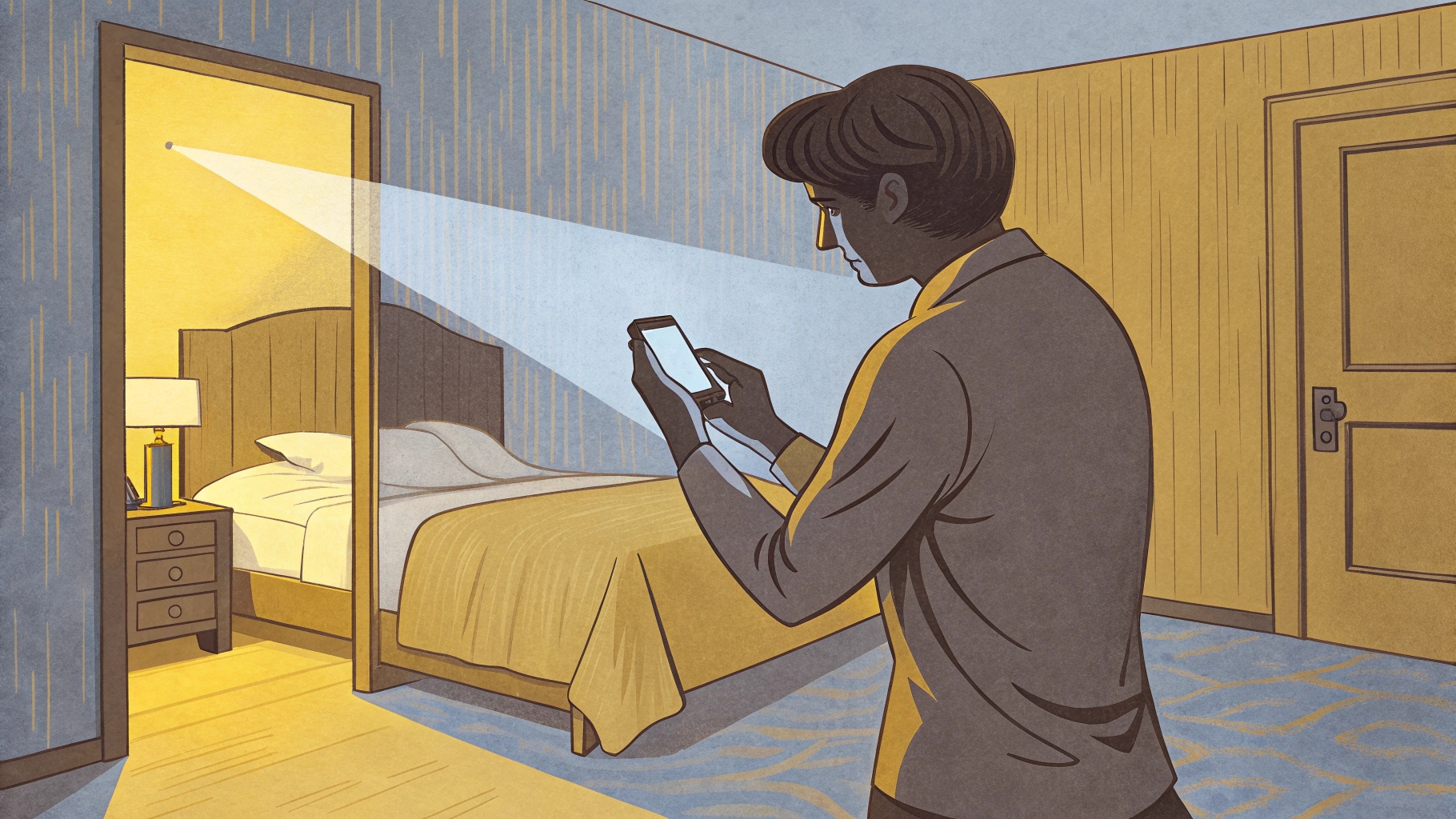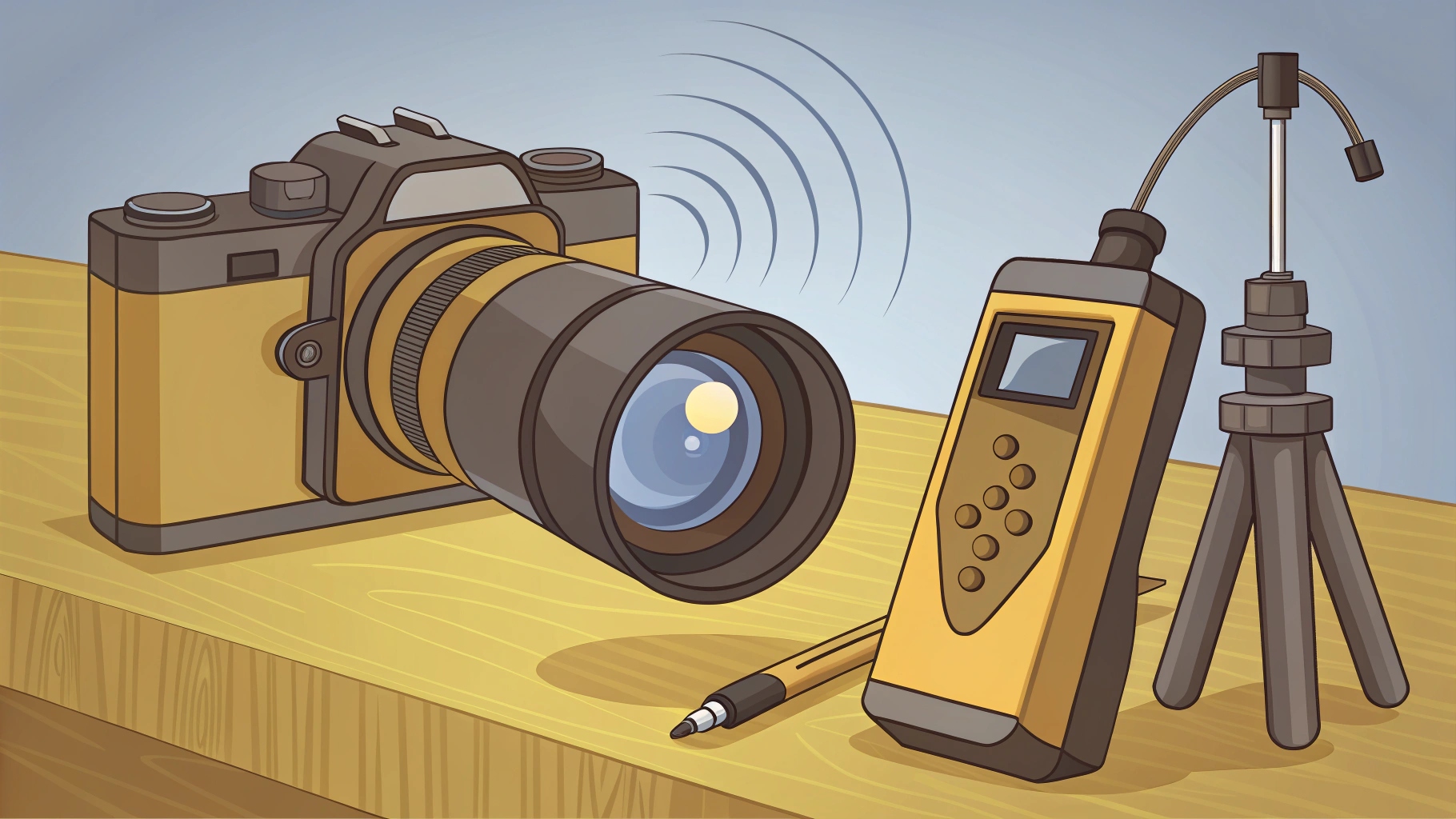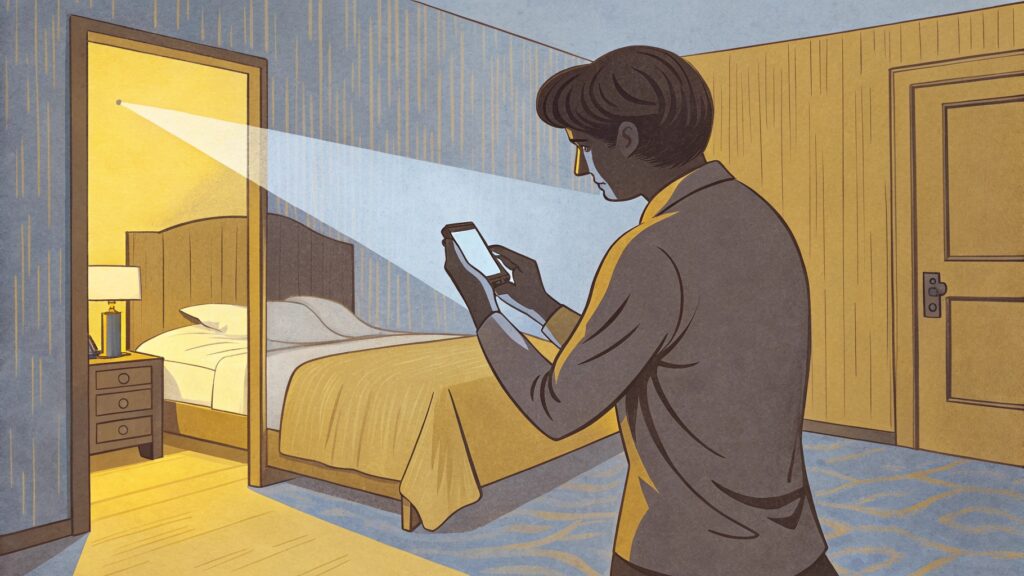The thought of a hidden camera1 in your hotel room2 is terrifying. These tiny devices can be hidden anywhere, making you feel completely exposed. I will show you how to find them.
To find a hidden camera1, first conduct a detailed physical inspection3 of the room. Use your phone's flashlight4 to scan for reflections from a camera lens5. Then, darken the room and use your phone's front-facing camera to detect the infrared (IR) lights6 used by night-vision cameras7.

My name is Taylor, and as a manufacturer of miniature cameras at QZT, I know exactly how these devices work. My client, Piotr from Poland, runs a successful e-commerce business. He buys our discreet camera modules8 for legitimate uses, like custom security devices9 his customers build themselves. But he and I have talked about the dark side of this technology. He said, "Taylor, your products are for security, but what about the ones used to violate privacy10?" This conversation highlighted my responsibility. I want to share my professional knowledge to help you protect yourself. This guide gives you the power to secure your own space.
Finding a camera in a public changing room feels urgent and difficult. You are exposed and have little time. But you can perform a quick, effective check in seconds.
Focus on objects at eye level or above that have a clear view of the space. Look for tiny holes in things like screws, coat hooks, or smoke detectors. Use your phone's flashlight4 to make a quick sweep for any unnatural lens reflections before you change.
<sup id=](https://q-z-t.com/wp-content/uploads/2025/08/how-to-detect-hidden-camera-in-changing-room-1-1.jpg)
At my company, we design our camera modules8 to be as small as possible for DIY projects11. The lens itself is often no bigger than a pinhead. This is great for innovation, but it also means malicious actors can hide them easily. When I discuss product design with my team, we always consider the potential for misuse. This is why I believe education is so important. A changing room is a high-risk area. You need a method that is fast and effective.
Here is a breakdown of what to look for and where.
Common Hiding Spots
These are the places you should check first. They offer the best vantage points for a hidden camera1.
- Coat Hooks: Some are manufactured with a camera already inside.
- Screws or Bolts: A pinhole camera can be disguised as a screw head.
- Light Fixtures or Smoke Detectors: They have power and a great overhead view.
- Air Fresheners or Vents: These objects have openings where a lens can be hidden.
Quick Detection Method
This table describes a simple, two-step process you can do in under a minute.
| Step | Action | What to Look For | Why It Works |
|---|---|---|---|
| 1. Physical Scan | Quickly look at hooks, screws, and fixtures. | Any tiny, perfectly round black dots or holes where they shouldn't be. | Camera lenses need a clear line of sight. |
| 2. Flashlight Scan | Turn on your phone's flashlight4. Sweep it across suspicious objects. | A bright blue or purple glint reflecting back at you. | Camera lenses are curved glass and will reflect light differently than plastic or metal. |
This quick check gives you a solid layer of protection. It uses the basic properties of a camera lens5 against itself. It is a simple but powerful way to reclaim your privacy10.
Feeling unsafe but don't have special gadgets? You might wonder if the phone in your pocket is enough to protect you. A cell phone is actually one of the best tools.
Yes, a cell phone can detect hidden camera1s in two ways. First, use its flashlight to spot lens reflections. Second, use the front-facing camera (which often lacks an IR filter) to see the infrared LEDs of night-vision cameras7, which are invisible to the naked eye.
<sup id=](https://q-z-t.com/wp-content/uploads/2025/08/can-a-cell-phone-detect-a-hidden-camera-feeli-1.jpg)
I often get questions from my B2B clients, like Piotr, about camera detection. He needs to assure his customers of privacy10. I explained to him that professional detectors12 are great, but a phone is something everyone has. The science is simple. The image sensor in some cameras, especially older or front-facing ones, can see a wider spectrum of light than our eyes. This includes the near-infrared light used by most security cameras to see in the dark.
My factory in Vietnam produces modules with high-quality night vision. These IR LEDs are powerful. Even though you cannot see their light, a camera can. This feature, designed for security, creates a weakness that you can exploit to find a hidden camera1.
Using Your Phone: A Step-by-Step Guide
Here’s how to use both of your phone’s cameras effectively.
Tertiary Heading: The Flashlight Method (For Any Camera)
- Turn off the lights in the room to reduce other reflections.
- Turn on your phone’s flashlight.
- Hold the phone near your eye and slowly scan the room. Pan across every object and surface.
- Look for a bright, pinpoint reflection. A camera lens5 will glint back at you.
Tertiary Heading: The Front-Camera Method (For Night-Vision Cameras)
- Make the room as dark as possible. Close curtains and turn off all lights.
- Open your camera app and switch to the front-facing camera.
- Slowly scan the room with your phone, looking at the screen.
- Watch for any small, pulsing, or steady purple or white dots of light on your screen. These are the IR LEDs.
You can test this method at home with a TV remote. Point the remote at your front-facing camera and press a button. You'll see the remote's IR emitter light up on your screen. This same principle will expose a hidden night-vision camera.
You just checked into a hotel. You want to relax, but a nagging feeling of being watched lingers. How can you be sure the room is private?
Perform a thorough, systematic search. First, check common hiding spots13 like smoke detectors, clocks, and power outlets. Use your phone's flashlight4 and front camera. Also, scan for unexpected Wi-Fi networks14 that might belong to a smart camera. A comprehensive check brings peace of mind.

I travel often for business, visiting partners and attending trade exhibitions. The first thing I do in any hotel room2 is a privacy10y sweep](https://www.priv.gc.ca/en/about-the-opc/what-we-do/international-collaboration/international-privacy-networks/international-privacy-sweep/)%%%FOOTNOTE_REF_15%%%. It’s second nature to me now. My experience as a manufacturer gives me an edge because I think about where I would place a device for the best view and power access. Most hidden camera1s are not in random locations. They are placed logically. They are in places that overlook the bed or the changing area. They are also placed in objects that have their own power source, like an alarm clock or a USB charger.
Understanding this logic is key. You don't need to tear the room apart. You just need to think like an installer.
A Hotel Room Inspection Checklist
Use this structured approach to cover all the bases.
Tertiary Heading: Physical Object Inspection
- Electronics: Look closely at alarm clocks, TVs, lamps, and especially USB wall chargers. Unplug them and inspect them for tiny lenses.
- Fixtures: Check smoke detectors, thermostats, and light switches. Look for anything that seems out of place.
- Furniture: Inspect the edges of mirrors, picture frames, and even tissue boxes.
Tertiary Heading: Technical Sweeps This table outlines the technical methods you can use.
| Method | Tool | How to Perform | What It Finds |
|---|---|---|---|
| Lens Detection | Phone Flashlight | Sweep the light across every object. | Physical camera lens5es (any type). |
| IR Light Detection | Phone Front Camera | Darken the room and scan with the camera. | Active night-vision cameras7. |
| Wi-Fi Scan | Phone Wi-Fi Settings | Look for unusual network names (e.g., "IPCAM," brand names, long strings of numbers). | Wi-Fi-enabled cameras broadcasting their own network. |
This methodical approach makes the task manageable. By checking both physical objects and digital signals, you can be very confident that your room is secure. It's a routine that takes five minutes but provides invaluable peace of mind for your entire stay.
You know the basic phone tricks, but are there more reliable methods? You may want a tool specifically designed for the job, especially if you travel frequently.
Yes, there are dedicated devices for this. RF (Radio Frequency) detectors16 can find the wireless signals that cameras transmit. Lens detectors use flashing red LEDs to make camera lens5es reflect brightly, making them easy to spot. These professional tools offer a higher level of certainty.

While I teach people to use their phones, I also recognize their limitations. For my most cautious B2B clients, especially those in security or private investigation, I recommend they invest in professional tools. We at QZT focus on making undetectable cameras for ethical security, so we must also understand the technology used to detect them. We test our own products against these devices to understand their capabilities.
An RF detector works like a radio. It scans for the frequencies that wireless cameras use to send video. When it finds one, it beeps or vibrates, getting stronger as you get closer to the source. A lens detector is simpler. It's a device with a ring of very bright LEDs around a viewfinder. When you look through it, the light from the LEDs bounces off any curved lens and creates an unmistakable flash.
Comparing Detection Methods
Here is a comparison of the different tools at your disposal.
| Detection Method | Pros | Cons | Best For |
|---|---|---|---|
| Human Eye | Free, always available. | Easy to miss tiny lenses. | A quick, initial check. |
| Phone Flashlight | Free, effective for finding lenses. | Can be fooled by other reflective surfaces. | A thorough physical search in any situation. |
| Phone Camera | Free, great for finding IR lights. | Only finds night-vision cameras7. Not all phones work. | Checking a dark room for active night-vision. |
| RF Detector | Finds active, transmitting cameras (Wi-Fi, Bluetooth, cellular). | Can't find wired or recording-only cameras. Can have false positives from routers. | Finding live-streaming wireless cameras. |
| Lens Finder | Excellent at spotting all camera lens5es, even if off. | Requires you to methodically scan every inch of a room. | The most reliable way to find any camera, on or off. |
For most people, a combination of a physical search and the phone methods is enough. But if you want the highest level of assurance, a combination RF and lens detector is the best investment you can make for your personal security.
Conclusion
You can effectively find hidden camera1s using your phone and a careful eye. By inspecting objects and scanning for lenses and IR lights, you can protect your privacy10 and feel secure.
Explore this resource to learn comprehensive techniques for identifying hidden cameras and ensuring your privacy. ↩
This link provides essential tips for inspecting hotel rooms for hidden cameras, ensuring your stay is private. ↩
Discover the importance of a thorough inspection to safeguard your privacy in various settings. ↩
Learn how to utilize your phone's flashlight effectively to spot hidden cameras in your environment. ↩
This guide teaches you how to spot camera lenses cleverly disguised in common items. ↩
Understand the role of infrared lights in surveillance technology and how to detect them. ↩
This resource explains the technology behind night-vision cameras and detection methods. ↩
Explore various camera modules to understand their applications and potential for misuse. ↩
This resource highlights effective security devices that can help protect your privacy. ↩
Explore strategies to safeguard your privacy and prevent unauthorized surveillance. ↩
Find inspiration for DIY security projects that can enhance your personal safety. ↩
Learn why investing in professional detectors can provide peace of mind and security. ↩
Explore this guide to identify typical locations where hidden cameras may be concealed. ↩
This link offers insights on spotting unusual Wi-Fi networks that could be linked to surveillance devices. ↩
Find out how to conduct a privacy sweep to ensure your personal space is secure. ↩
Discover how RF detectors can enhance your ability to find wireless hidden cameras. ↩


